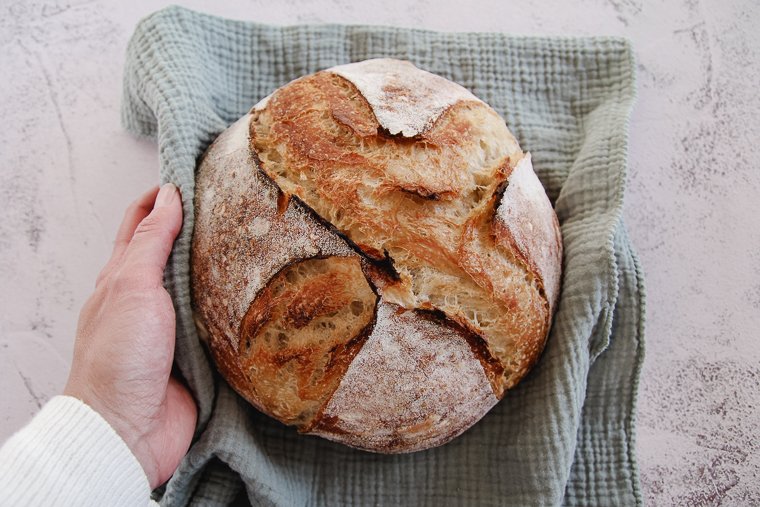
This post may contain affiliate links. See my full disclosure. As an Amazon Associate, I earn from qualifying purchases.
When you’re new to baking sourdough bread, you’ll likely come across unfamiliar terms as you try new recipes. Don’t be intimidated! Here are the simple explanations (and some short video demonstrations) that you’ll need to build your knowledge and confidence.
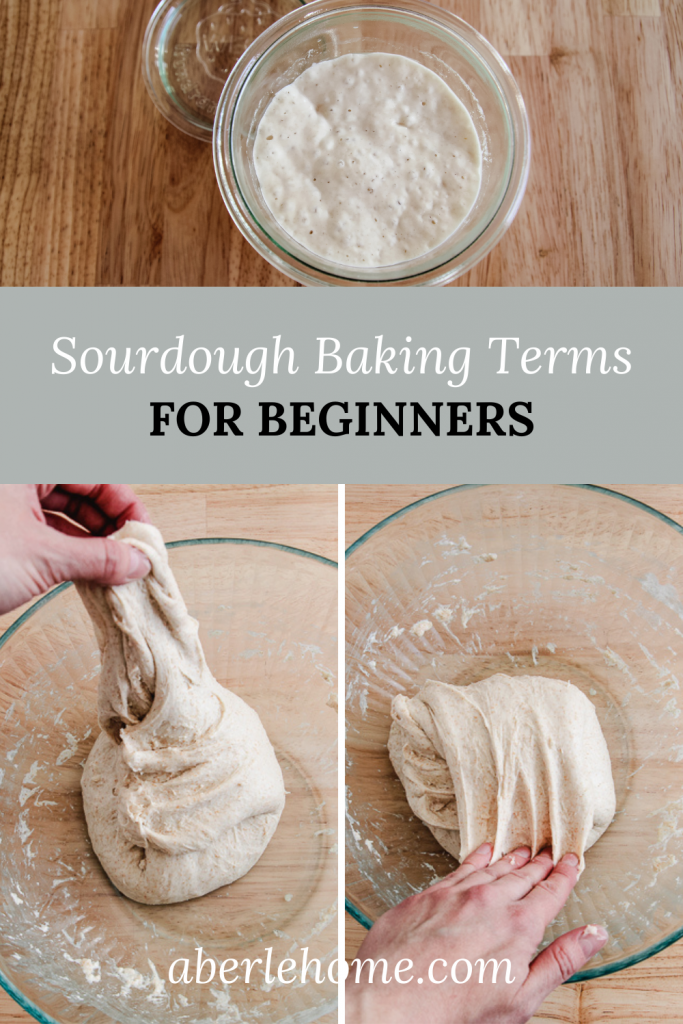
I’ve been sharing sourdough recipes for a while now like my Sourdough Pizza Crust, Soft Sourdough Potato Rolls, and Sourdough Soft Pretzels.
If you don’t have a sourdough starter yet, you can learn how to make one in this post or purchase fresh sourdough starter here.
But I think it’s high time I publish some helpful posts on my blog for those who are just learning how to bake sourdough bread, starting with this post on sourdough baking terminology.
There’s so much information out there that it can feel overwhelming to encounter recipes with these terms–especially if you’re new to bread baking in general!
I hope this post presents these terms in a way that you can process and begin to apply in your own kitchen.
When you’re finished here, you may want to visit my post, Essential Sourdough Bread Making Tools.
Sourdough Bread Baking Terminology (In Alphabetical Order)
A
Active (Ripe) Starter – An active starter is one that has been allowed to rise after a feeding to reach its peak (or has just started to fall again). It will look very bubbly. The time it takes starter to mature will depend on the strength of your starter, the ratio of starter to the flour and water you’ve added for the feeding, and how warm the water and your kitchen are.
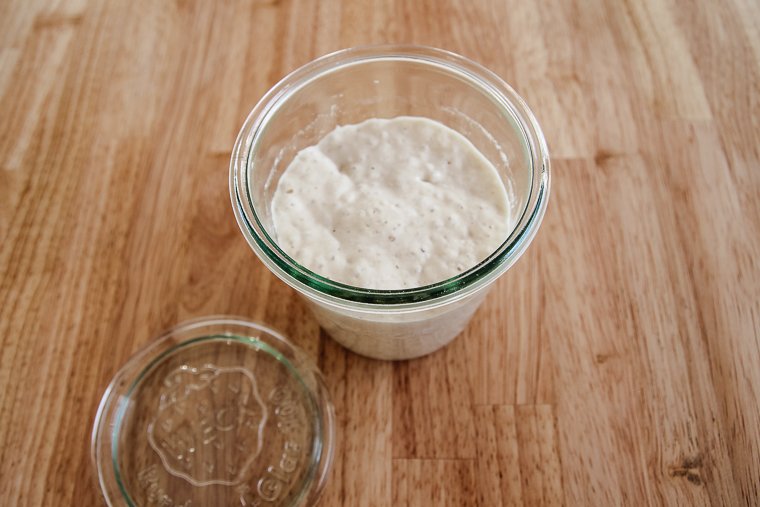
All-Purpose Flour – All-purpose flour is a refined flour because the germ and bran have been removed in the milling process. It is suitable for many baking projects but may not have enough strength for certain breads. It has less protein than bread flour at 10%-12% protein.
Alveoli – Alveoli are the holes inside of sourdough bread.
Ambient Temperature – The ambient temperature (room temperature) is the temperature of the air in your kitchen which will affect the temperature of your dough. You can measure ambient temperature with an ambient thermometer.
Autolyse – An autolyse (pronounced “auto-lease”) is a time of rest after the flour and water are mixed together, before any other ingredients are added. Autolysis gives the flour time to absorb the water properly to kickstart gluten development and to give your bread better flavor. Different recipes will call for different autolyse lengths.
B
Baguette – A baguette is a long, thin, oval-shaped loaf of bread, usually over one foot long. Here is one way to shape a baguette.
Baker’s Percentage (Baker’s Math) – You might be nervous when find a sourdough recipe and see a table with percentages… but don’t fret! These percentages show the relationship between the flour in the recipe and every other ingredient.
The total flour will always be 100% (when more than one type of flour is used, the total of both will add to 100%). The total of the percentages of the other ingredients will not add up to 100%. If you want to find the baker’s percentage for an ingredient in a recipe, you can divide the weight of that ingredient by the weight of the flour and multiply the total by 100.
Baker’s Timeline (Baker’s Schedule) – The timeline tells you how you can time your baking process to work into your schedule. Sourdough baking isn’t usually any more difficult than baking with commercial yeast, but there are larger intervals of time passing between the steps. It’s important to plan ahead.
Banneton (Proofing Basket or Brotform) – A round or oval banneton is a basket used to hold dough to help it keep its shape during its final rise.
A cane banneton can be used with or without its muslin or linen liner, however, it will need to be seasoned prior to the first use if no liner is to be used. Dampen the inside with a spray bottle and dust with a layer of flour. Allow it to dry before using it for proofing dough.
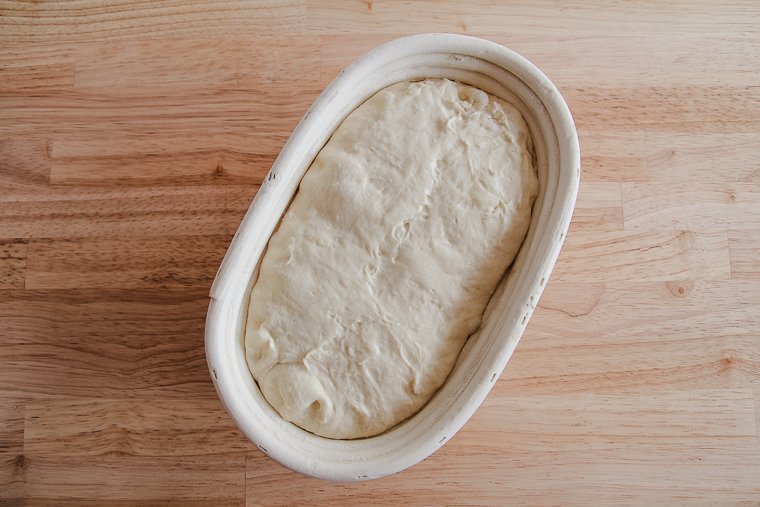
Bassinage – A French term for adding additional water to dough after some initial strengthening has already been done to develop the gluten network.
Batard – An oval or football-shaped loaf of bread is called a “batard.” Here is a good way to shape a batard.
Bench Rest – This is when you allow your dough to rest on the bench or counter (sometimes covered, sometimes in the open air) to allow the gluten in the dough to relax before rolling or shaping. If you are rolling dough for a recipe and it keeps springing back smaller, a bench rest for 10-15 minutes will help it to relax.
Bench Scraper (Bench Knife or Dough Scraper) – These are tools you can use an an extension of your hand when handling sticky dough. A bench knife is useful for dividing and shaping dough and scraping your work surface clean. A flexible dough scraper can help you remove dough from a bowl without deflating it.

Bloom – Blooming is the act of the sourdough bread crust opening at the score lines during baking.
Boule – A boule (pronounced “bool”) is a round-shaped loaf of bread. Here is one way to shape a boule.
Bran – Bran is the outer layer of a kernel of grain. The bran is removed when refining white flour, but is retained in wholegrain flours. You can purchase bran separately to use in recipes.
Bread Flour – Bread flour has a high protein content (12%-14%), giving extra structure, elasticity, and rise to bread.
Bulk Ferment (Bulk Rise or First Rise) – This is the time period between the mixing of your ingredients and the final shaping. Dough develops flavor and strength and increases in volume during this time.
Sometimes stretch-and-folds are performed at intervals during the bulk fermentation to gently increase the strength of the dough without deflating it. The bulk phase usually takes anywhere from 3 to 12 hours at room temperature, depending on the recipe. Sometimes the final phase of bulk fermentation will take place in the refrigerator.
It can be quite challenging to determine when to end bulk fermentation, and you can experiment with different timings to see how your bakes are affected. Generally, dough should have increased in volume and look smooth and bubbly at the end of bulk.

C
Coil Fold – Coil folding is a gentle way to add strength to a dough by lifting it out of its bulk fermentation container and allowing it to fold over itself. Here is a demonstration.
Couche – A couche (pronounced “koosh”) is a piece of thick linen used as a resting place for baguettes during their final rise to help them keep their shape before baking.
Crumb – The crumb is referring to the pattern and size of holes (or alveoli) when you slice into a loaf of bread. An “open” crumb means the interior looks open and airy and has holes you can see through.
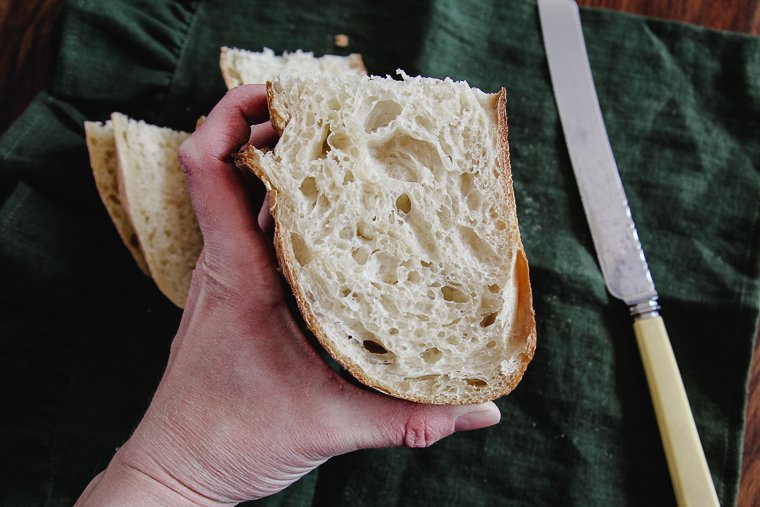
D
Danish Dough Whisk – This is a thick flat whisk with layered coils and a thick handle designed to easily mix dough or thick batters.
Degas (Punch Down or Knock Back Dough) – After the first rise or bulk fermentation, some recipes may instruct you to punch down or degas the dough before shaping. This can be done with your fist in a bowl of risen dough, or you can press your dough with the palms of your hands on your workbench to remove the air bubbles.
Desired Dough Temperature (DDT) – Desired dough temperature is the temperature you want your dough to measure at the end of mixing (the start of bulk fermentation). Dough temperature is affected by the temperatures of the air, flour, and water, and friction from mixing. The dough temperature will affect how quickly the dough will develop in the bread-making process and can be measured with an instant-read thermometer.
Discard Starter – This is extra starter that you need to get rid of before feeing your remaining starter. You can throw it in the trash, compost it, or save it in a separate container to use in a sourdough discard recipe (and in this case, you will not need to feed it before using).
Divide Dough – This means to cut the dough into equal portions for multiple loaves, dinner rolls, etc. You can weigh the pieces you cut for accuracy and even baking.
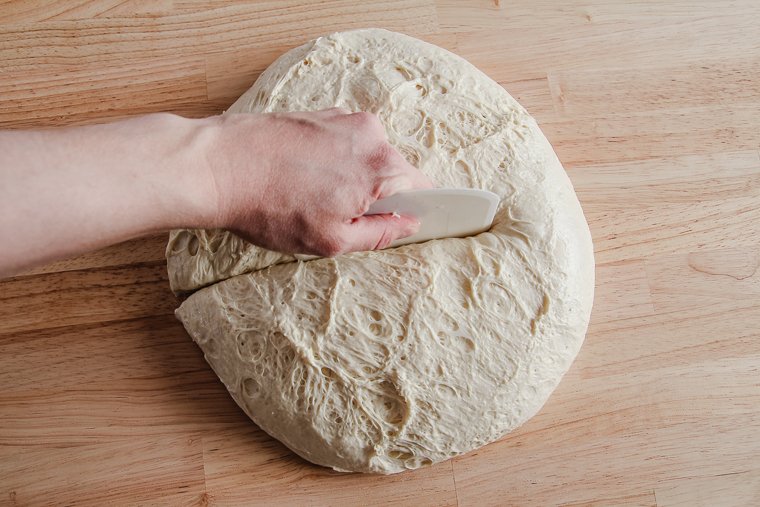
Dough Strength – Dough strength is referring to how developed the gluten is in a dough. The strength will depend on the type of flour used and how much the gluten has been developed through kneading or stretch-and-folding.
Dutch Oven – This is an oven-safe covered pot that can be used for baking at high temperatures. It transfers heat to dough quickly and traps the steam to help the dough to rise to its full potential before the crust sets. Another option to use in place of a Dutch oven is a cast iron combo cooker or other oven-safe lidded cooker.
E
Ear – When a loaf is scored properly and has good rise in the oven, one side of the score will raise up and bake into a crunchy flap on top of your loaf. This flap is known as an “ear.”
Egg Wash – An egg wash is mixture of beaten egg (or egg white or yolk) and water, milk, or cream. It is brushed over a baked good to make it shiny and golden during baking. It can also be used to seal the edges of a pastry.
Elasticity – Elasticity is a dough’s ability to bounce back after it is stretched.
Endosperm – The endosperm is the starchy portion of the wheat kernel that makes up refined white flour after the bran and germ are removed.
Enriched Dough – An enriched dough is made more tender with the edition of fat, dairy, and/or sugar. Since these ingredients slow fermentation, an enriched dough will rise/proof slower than a lean dough will.
Extensibility – This is referring to a dough’s ability to stretch without tearing.
F
Feed Starter – Feeding a starter is the process of adding fresh flour and water in a certain ratio. The microbes in the starter metabolize the sugars in the flour to stay healthy. A 100% hydration starter is the most common, meaning the starter is fed equal weighs of flour and water at a minimum 1:1:1 ratio of starter, flour, and water (or with a small ratio of seed starter). Some people choose to keep an even stiffer starter.
Final Dough Temperature – The temperature of the dough at the end of mixing and the start of bulk fermentation is called the final dough temperature. It will need to match the desired dough temperature (DDT) outlined in a recipe for the timeframes to work. The dough temperature can be measured with an instant-read-thermometer.
Final Shaping – Usually after a preshape and short rest, dough is given its final shape directly before it is baked. The process of shaping correctly adds surface tension to the dough to help it retain its shape.
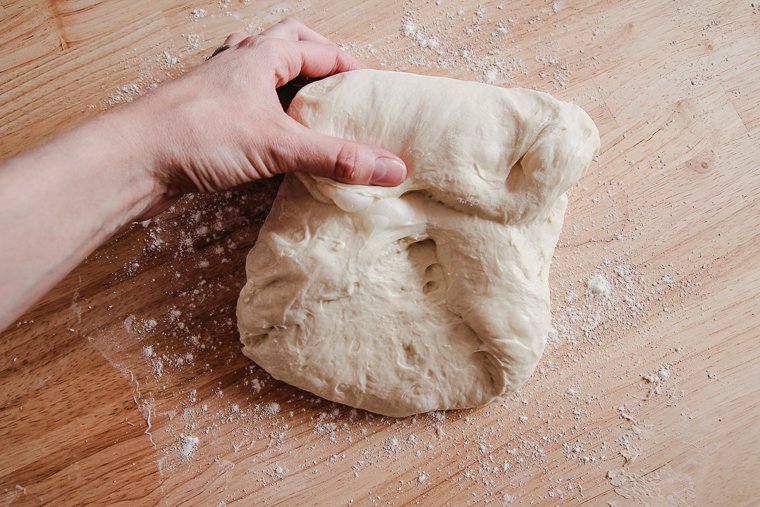
Flatbread – These breads are flattened before baking or cooking in a pan. Some flatbreads contain leavening like sourdough starter, but others do not. Some examples are tortillas, pita, naan, focaccia, and sourdough pizza.
Float Test – After you’ve fed your sourdough starter and allowed it to peak, you can drop a small dollop of the starter into a glass of water. It will often float when it’s ready to bake with. This test is often unreliable, though, depending on which flour you use to feed your starter.
Freshly-Milled Flour – This is flour made by stone-grinding or impact-grinding the entire kernel of grain (which includes the endosperm, the bran, and the germ). You can make your own freshly-milled flour at home with a countertop grain mill.
G
Germ – The germ is the embryo of the seed in a kernel of wheat. The germ is removed when refining white flour but is retained in wholegrain flours. You can purchase wheat germ separately to use in recipes.
Gluten – Gluten is a protein that forms the structure of bread, making the dough stretchy/elastic and the bread chewy.
H
Heirloom Wheat – An old wheat variety that has been passed down from previous generations and hasn’t been genetically modified is an heirloom wheat. A few examples are einkorn, emmer, spelt, and kamut.
Hooch – Hooch is a harmless, gray or brown-colored liquid that will form on top of a sourdough starter that needs a feeding. Hooch does not indicate that your starter has died.
Hydration – Hydration is referring to the amount of water in a dough in relation to the flour. A higher hydration bread will have a more open crumb and a thinner, more crackly crust.
I
Instant-Read Thermometer – An instant-read thermometer can give a quick temperature reading of dough to determine how fast it will ferment or of a loaf of bread to determine if it’s done baking.
K
Knead – Kneading is the act of pushing, folding, and pulling the dough to develop strength and elasticity. Kneading can be done by hand on the countertop or in an electric mixer fitted with a dough hook. Generally, lower hydration doughs will require a kneading. Here is a demonstration of how to knead by hand.
L
Lactic Acid – This acid is produced by the yeasts in a sourdough starter and give sourdough bread a tangy flavor. There are adjustments you can make in sourdough baking for bread that is more or less sour.
Lactobacilli – Important fermenting bacteria called lactobacilli are found in the microbial makeup of sourdough starter.
Lame – A lame (pronounced “lahm”) is a razor blade on a handle used to score bread dough. A lame can be dampened with water to help it slide through the dough even easier.
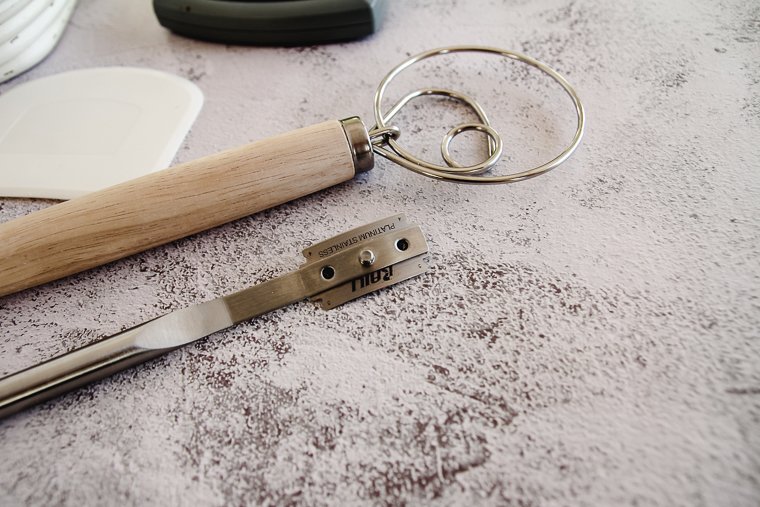
Laminate – Laminating is a process of creating multiple thin layers of dough and butter that will bake into flaky layers of pastry. This method is used to make croissants, Danishes, and puff pastry. You can visit my posts for Homemade Sourdough Croissants or Sourdough Danish Pastries to learn how to do this.
Lean Dough – A lean dough is low in fat and sugar, oftentimes having neither. A sourdough bread with only flour, water, starter, and salt (like my Long Fermented Artisan Sourdough Bread) is an example of a lean dough.
Levain (Leaven or Preferment) – Levain is a preferment made with a little starter, some flour, and water (and sometimes sugar), and left to ferment before you include it in your loaf as the leavening.
A levain is a way to increase the amount of starter you have to work with if you keep a small starter. You can also use a levain to control the performance and flavor (and sometimes sourness) of your dough without making any changes to your mother starter. Some recipes call for more than one levain to build flavor in a bread.
M
Maintain a Starter – After making a starter from scratch or receiving starter from a friend, you’ll want to maintain it with regular feedings of unbleached flour and un-chlorinated (or filtered) water. Daily feedings will be required for a starter that is stored at room temperature. Weekly feedings will be required for a starter that is stored in the refrigerator.
Mix – Mixing is simply combining ingredients together until no dry flour remains.
N
Naturally Leavened – Naturally leavened bread is leavened with a sourdough starter (also known as wild yeast) instead of commercial yeast. Many bakers not-so-jokingly call sourdough bread “real bread.”
No-Knead Bread – Many artisan-style bread recipes are no-knead, meaning the ingredients are simply mixed and left to ferment, usually with some stretch-and-folds at certain intervals to strengthen the dough.
O
Oven Spring – Good oven spring, or the ability of dough to rise well during baking before the crust sets, is a desirable trait when baking sourdough loaves. Many factors affect oven spring.
Overproofed Bread – Sourdough bread that was fermented too long before baking.
P
Pastry Flour – Pastry flour is a lower protein flour (around 8%) suitable for baked goods that should be light and tender (e.g. pie crust, biscuits, and scones). This flour would not be suitable for bread doughs. There is white or whole wheat pastry flour available, or you can grind your own whole wheat pastry flour using “soft white wheat” berries.
Poke Test – Proofing is done in most cases when the dough springs back only slightly when poked with a wet finger (the poke test). If the indent stays deeply, the dough has likely over-proofed and may soon collapse or flatten during baking. If the indent bounces back quickly and all the way, the dough needs more time to proof.
Preshape – A step where form is added to a dough after bulk fermentation to help with a successful final shaping later. Since preshaping creates a smooth surface on the dough and adds strength, this step should not be skipped if called for.
Proof (Second Rise or Final Rise) – Proofing is the final rise dough goes through after the final shaping and just prior to baking. If you underproof, your bread can turn out gummy, tight and dense. If you overproof, you risk the dough collapsing once you bake it. Here is a video demonstration of proper proofing. Sometimes the term “proof” is referring to the overall fermentation of a loaf.
Proofer – A proofer is a piece of foldable equipment shaped like a box in which you can place dough (or starter) to keep it at a consistently warm temperature for fermenting or proofing.
Protein – Gliadin and glutenin are two proteins in flour. The amount of these proteins and the ratio between them varies widely in different varieties of flour. These differences affect the gluten-forming ability of each flour.
Q
Quick Bread – Quick breads are usually made with baking soda or baking powder as the leavening agent instead of yeast (if sourdough starter is added, it is for flavor only). There is no wait time between mixing the ingredients, pouring into a prepared pan, and baking. Some examples are my cranberry banana bread, muffins, biscuits, and Irish soda bread.
R
Retard – To retard is to slow a part of the fermenting process by keeping the dough in the refrigerator. It is not uncommon for a baker to retard during part of bulk fermentation or for the entire proof after the dough has been shaped.
The activity in a sourdough starter can also be slowed by keeping a starter in the fridge between baking projects. This eliminates the need for a daily feeding.
Rice Flour – Because rice flour doesn’t contain gluten, it won’t absorb water the way wheat flour does. This makes it the best choice for dusting proofing baskets to allow dough to release cleanly for baking.
Rubaud Method – The Rubaud method is a style of mixing a high-hydration dough by hand to develop the gluten structure. The hand is held in a cup shape and moved quickly through the dough in an upwards pulling motion–almost like the hook on a mixer.
S
Scale Ingredients – Weighing ingredients on a digital kitchen scale will help you follow another baker’s recipe with consistency. You’d be surprised how inconsistent volume measurements can really be from one baker to the next. Using weight measurements also makes it much more simple to scale a recipe up or down when necessary.
Score (Slash) – Scoring is the process of cutting a slash in dough with a lame or razor blade to allow the loaf to expand properly in the oven without cracking randomly. Some recipes call for chilling shaped loaves to make scoring easier. See how to properly score dough here.
Semolina Flour – This coarse yellow flour is made from durum wheat. Although it’s usually used in pasta dough, you might also see it used to dust the bottom of a loaf of bread or bagels. It adds texture and prevents sticking.
Sift – When grinding your own fresh flour from whole kernels of grain, there may be times when you’ll want to sift out a portion of the bran or germ using a sifting screen. The finer the screen, the more bran and germ will be sifted out.
Slap and Fold – This is a way to strengthen a very sticky dough without adding additional flour. The dough is slapped against the bench and then folded over itself. Here is a demonstration.
Sourdough Starter – A sourdough starter is an active culture of beneficial yeasts and bacteria. It is maintained and used to naturally leaven bread dough in place of commercial yeast. A small portion of the starter is always saved and maintained for future baking projects.
Stretch and Fold – This is a technique where you stretch dough just shy of the point of tearing and fold it back over itself. This method builds strength in the dough without deflating the gasses that are developing, and you can do it right in a bowl.
A dough may require a few sets of these stretch and folds at different intervals during bulk fermentation. Here is a video of how this is done.

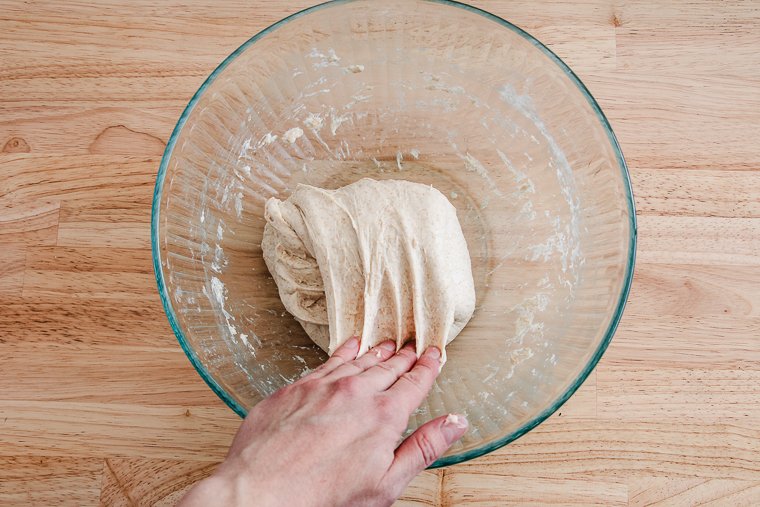
T
Tangzhong (Roux, Scald, or Yudane) – A tangzhong is a cooked, thickened flour and water or flour and milk mixture that is added to dough to make it soft and billowy.
Temperature – Keeping dough at a consistent temperature during fermentation yields consistent results, so you may notice that some sourdough bread recipes mention temperatures for the steps. Temperature will affect the flavor and how slowly or quickly dough ferments.
Some home bakers will buy a proofer box to keep their dough at a desirable temperature. I often leave my dough in my (not heated) oven with the light on for extra warmth.
U
Unbleached Flour – You’ll want to use unbleached flour when feeding your sourdough starter and baking sourdough bread. The process of bleaching flour strips it of its natural yeasts which are needed in sourdough baking.
Underproofed Bread – Bread that was not given adequate time to ferment before being baked and doesn’t display signs of proper fermentation. A weak starter can sometimes be the culprit.
W
Windowpane Test – If dough passes the windowpane test, it will stretch thin enough to see the light through it when you pull it with damp fingers. This indicates that the gluten is well developed in the dough.
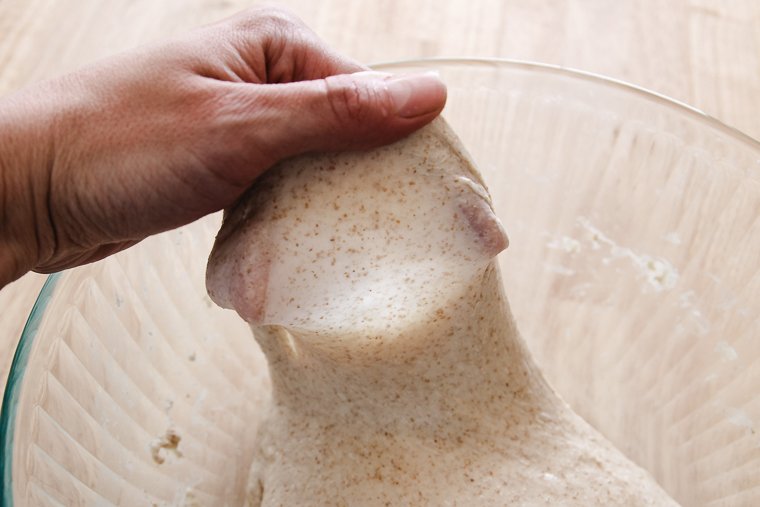
Wholegrain Flour – Wholegrain (or wholemeal) flour has been ground from whole, unprocessed grain. It contains more fiber and nutrients than all-purpose flour since it contains the germ and bran of the wheat kernel, but also has a shorter shelf life.
Y
Yeast – Simply put, yeasts are single-celled organisms that convert carbohydrates into carbon dioxide and alcohols through a process called “fermentation.” The gas that is produced during fermentation leavens dough. Yeast can be purchased in different forms or cultivated naturally in a sourdough starter.

Do you have a recipe for sourdough discard focaccia bread
Hi Shirley! Not yet, but I hope to in the future!